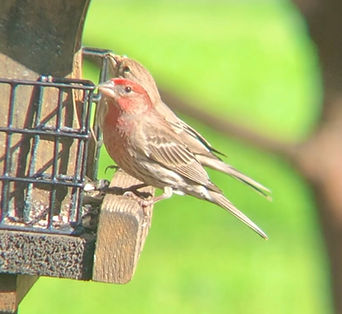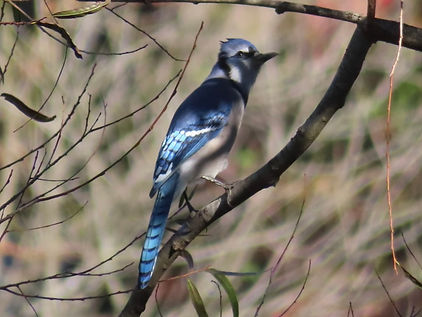
Bonus Lesson #2: Common Feeder Birds in ATL
Lesson:
This webpage is geared to residents of the Atlanta Metro Area due to the specific species that will be mentioned, but people from all over the world are welcome to make use of it!
While Atlanta has over 250 species of birds—including both permanent residents and migratory ones just passing through—only a fraction of these species come to the feeders. This lesson aims to educate students about the most likely species that will come to backyard feeders or near them, though please note that the list is not exhaustive!
Activity:
Take this log outside (or to a window spot) every day for a set period of time (1–2 weeks, but it can be longer) and record the date, time, and bird species observed at the feeder. This activity can be solo or communal—the latter is, of course, preferred! The goal is to learn to identify some of the most common birds that can be easily seen even in urban areas. Hopefully by doing so, students will gain a larger appreciation of the beauty and diversity of nature. This log also provides consistent data for a singular location.
If this log is being completed during the months of November–April, please upload all data to Cornell Lab of Ornithology's Project FeederWatch to contribute to the international data collection program as well as forward a copy to birdingforbeauty@gmail.com. If not being completed during those months, please only send the copy to birdingforbeauty@gmail.com
Species: Northern Cardinal
Time of year: year-round
Feeder food preferences:
-
Sunflower seeds
-
Black oil sunflower seeds
-
Striped sunflower seeds
-
Sunflower kernels
-
-
Shelled peanuts
-
Safflower seeds
-
Cracked corn
Feeder:
-
Tube feeder with perches
-
Gazebo feeder

Female

Male
Species: House Finch
Time of year: year-round
Feeder food preferences:
-
Nyjer
-
Finch blend
-
Hulled sunflower seeds
-
Cracked corn
-
White millet
Feeder:
-
Tube feeder
-
Finch feeder

Male (front) and female (behind)
Species: Carolina Chickadee
Time of year: year-round (increased in winter)
Feeder food preferences:
-
Black oil sunflower seeds
-
Hulled sunflower seeds
-
Safflower seeds
-
Suet
-
Mealworms
-
Peanut pieces
Feeder:
-
Tube feeders
-
Specialty chickadee feeders

Male and female are nearly identical to the human eye
Species: Tufted Titmouse
Time of year: year-round (increased in winter)
Feeder food preferences:
-
Black oil sunflower seeds
-
Safflower seeds
-
Peanuts
-
Mealworms
-
Nyjer
-
Suet
Feeder:
-
Tube feeders
-
Hopper feeders
-
Platform feeders
-
Suet feeders

Male and female are nearly identical.
Species: Downy Woodpecker
Time of year: year-round (increased in winter)
Feeder food preferences:
-
Suet
-
Sunflower seeds
-
Cracked corn
-
Peanuts
-
Peanut butter
-
Mealworms
Feeder:
-
Suet feeders
-
Platform feeders
-
Large hopper feeders

Female

Male (red nape)
Species: Red-bellied Woodpecker
Time of year: year-round (increased in winter)
Feeder food preferences:
-
Black oil sunflower seeds
-
Suet
-
Peanuts
-
Mealworms
Feeder:
-
Suet feeders
-
Platform feeders

Male; females have a red patch, but it only extends to the neck and not the crown.
Species: Blue Jay
Time of year: year-round (increased in winter)
Feeder food preferences:
-
Peanuts
-
Sunflower seeds
-
Suet
-
Cracked corn
-
Acorns
Feeder:
-
Tray feeders
-
Tube feeders
-
Hopper feeders

Male and female look nearly identical.
Species: Mourning Dove
Time of year: year-round (increased in winter and migration)
Feeder food preferences:
-
White millet
-
Safflower seeds
-
Cracked corn
Feeder:
-
Platform or tray feeders
-
Ground feeding

Males may have slightly brighter colorations, such as a blue tinted crown, but differences are minimal.
Species: Northern Mockingbird
Time of year: year-round
Feeder food preferences:
-
Fruit
-
Suet
-
Mealworms
Feeder:
-
Platform or tray feeders
-
Ground feeding

Male and female are nearly identical.
Species: Brown Thrasher
Time of year: year-round
Feeder food preferences:
-
Fruit
-
Sunflower seeds
-
Suet laced w/ peanut butter
-
Mealworms
Feeder:
-
Ground feeding

Male and female are nearly identical.
Species: Dark-eyed Junco
Time of year: winter
Feeder food preferences:
-
Millet
-
Sunflower seeds
-
Cracked corn
Feeder:
-
Platform/tray feeders (low-hanging!)
-
Ground feeding

Males and females are slightly sexually dimorphic. Males are more slate-colored, while females are more brown.
Species: American Goldfinch
Time of year: year-round (increase in winter)
Feeder food preferences:
-
Shelled sunflower seeds
-
Nyjer
-
Millet
-
Thistle seed
Feeder:
-
Tube feeder

Male in breeding plumage; females are duller yellow on chest and olive-colored on back. In winter, colors become duller for both sexes.
Species: White-breasted Nuthatch
Time of year: year-round (increase in winter)
Feeder food preferences:
-
Sunflower seeds
-
Peanuts
-
Suet
-
Peanut butter
Feeder:
-
Hopper feeders
-
Platform feeders
-
Suet feeders (ocasionally)

Males and females have subtle sexual dimorphism; males have black crowns, and females have gray crowns. Differences are subtle.